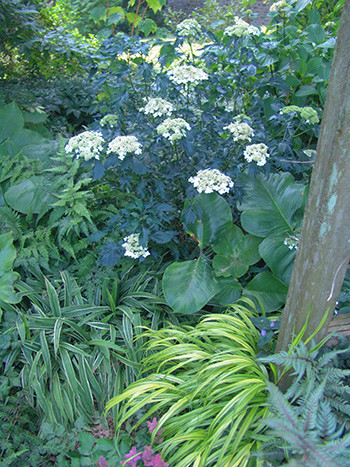
Hydrangea arborescens ‘Riven Lace’

A common garden plant in the Eastern United States, Hydrangea arborescens is often bred to display large, heavy inflorescences seen in H. arborescens ‘Annabelle’ or ‘Invincibelle Spirit’, though ‘Riven Lace’ is an exception in that the inflorescences most closely resemble the characteristics of Hydrangea arborescens in the wild: tea-saucer sized corymbs with a few exaggerated bracts dotting the perimeter.
Native to the moist woodlands of the Eastern United States, H. arborescens generally prefers moist conditions in partial shade. Well drained soils are a must, though it will not stand drought conditions. Flowers of this species will emerge on new wood, so it is recommended to prune to the ground annually. This process will keep it in a nice tight form at a maximum of three to four feet tall and wide.

H. ‘Riven Lace’ offers an interesting variation with deeper serrations than found on the leaf margins of the species; riven means violently torn or split. photo credit: R. Robert
Unmistakably a member of the hydrangea family Hydrangeaceae, its heritage is betrayed by its opposite leaf arrangement, corymb flower head, and general habit. ‘Riven Lace’ offers an interesting variation with deeper serrations than found on the leaf margins of the species; riven means violently torn or split. The leaves have a ragged, torn appearance which is surprisingly attractive despite the description.
Above the foliage appear delicate white flower heads which hint at the larger lacecap varieties often seen in this family. The center of the corymb is a collection of diminutive, fertile flowers, while showy, infertile bracts appear randomly giving a very light appearance above the deep green leaves.

The center of the corymb on H. ‘Riven Lace’ is a collection of diminutive, fertile flowers, while showy, infertile bracts appear randomly giving a very light appearance above the deep green leaves. photo credit: J. Bickel
Missouri Botanical Garden cites the etymological derivation the species as a combination of greek roots “hydor meaning water and aggeion meaning vessel in reference to the cup-like capsular fruit,” while the species name simply means “tree-like.”
H. arborescens ‘Riven Lace’ can also be found in the market under the synonymous cultivar name Hydrangea arborescens ‘Green Dragon’. Two specimens can be found in the Terry Shane Teaching Garden at the Scott Arboretum. One under the cultivar name ‘Green Dragon’ and the other sporting the more common cultivar name ‘Riven Lace’.





Cynthia Gonnella
Posted at 12:09h, 14 AprilHi, the leaves for arborescens are typically heart-shaped and the leaves in the photo look more like an oak leaf hydrangea.
Becky Robert
Posted at 10:53h, 16 AprilThe distinctive foliage is the main attribute that makes this cultivar unique.
Josh Coceano
Horticulturist
Scott Arboretum